
International Gothic is a period of Gothic art which began in Burgundy, France, and northern Italy in the late 14th and early 15th century. It then spread very widely across Western Europe, hence the name for the period, which was introduced by the French art historian Louis Courajod at the end of the 19th century.
Artists and portable works, such as illuminated manuscripts, travelled widely around the continent, leading to a common aesthetic among the royalty and higher nobility and considerably reducing the variation in national styles among works produced for the courtly elites. The main influences were northern France, the Netherlands, the Duchy of Burgundy, the Imperial court in Prague, and Italy. Royal marriages such as that between Richard II of England and Anne of Bohemia helped to spread the style.
It was initially a style of courtly sophistication, but somewhat more robust versions spread to art commissioned by the emerging mercantile classes and the smaller nobility. In Northern Europe "Late Gothic" continuations of the style, especially in its decorative elements, could still be found until the early 16th century, as no alternative decorative vocabulary emerged locally to replace it before the Renaissance revival of Classicism.

Usage of the terms by art historians varies somewhat, with some using the term more restrictively than others. Some art historians feel the term is "in many ways ... not very helpful ... since it tends to skate over both differences and details of transmission."
Development
The important Bohemian version of the style developed in the court of Charles IV, Holy Roman Emperor in Prague, which for a brief period became a leading force in the development of European art. Charles came from the Luxembourg dynasty, was tutored by the future Pope Clement VI, and as a youth spent seven years at the French court, as well as visiting Italy twice. This and family relationships gave him intimate links with the various courts of France, including that of the Avignon Papacy, and from 1363 the separate Valois Duchy of Burgundy under Philip the Bold. The Bohemian style initially lacked the elongated figures of other centres, but had a richness and sweetness in female figures that were very influential. Charles had at least one Italian altarpiece, apparently made in Italy and sent to Prague, near where it remains today in his showpiece Karlštejn Castle. For St. Vitus Cathedral in Prague, he first used a French architect, and then the German Peter Parler.
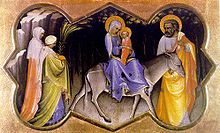
Much of the development of the style occurred in Italy, and it probably spread north of the Alps to influence France partly through the colony of Italian artists attached to the Papal Court at Avignon, and the works displayed from the residence there in the 1330s and 1340s of Simone Martini, a Sienese precursor of the style. Republican Siena had a large influence on the development of the style, but kept to its own dignified Gothic style throughout the period, and afterwards, while the flamboyant Visconti court at Milan, also closely related to the French royal family, was the most important Italian centre of the courtly style. As the style developed in Northern Europe, Italian artists were in turn influenced by it.
The marriage in 1384 between the young King Richard II of England and Charles IV's daughter Anne of Bohemia helped to connect Prague and London, and bring the style to England, although Anne died in 1394.
Royal portraits
A number of central works of International Gothic work are votive portraits of monarchs with a sacred figure – in some cases being received into Heaven by them, as with a miniature of Jean, Duc de Berry, and some of his relatives, being welcomed by Saint Peter in the Très Riches Heures du Duc de Berry. From this period come the earliest surviving panel portraits of monarchs, and royal manuscripts show a greatly increased number of realistic portraits of the monarch who commissioned them.
-
 The Votive Panel of Jan Očko of Vlašim. Kneeling Emperor Charles IV and his son Wenceslaus before the Virgin, Bohemia, 1371. (detail)
The Votive Panel of Jan Očko of Vlašim. Kneeling Emperor Charles IV and his son Wenceslaus before the Virgin, Bohemia, 1371. (detail)
-
 Jean de Vaudetar, chamberlain of king Charles V of France, presents his gift of a manuscript to the King, 1372.
Jean de Vaudetar, chamberlain of king Charles V of France, presents his gift of a manuscript to the King, 1372.
-
 The Wilton Diptych 1395–99. King Richard II of England kneels. (left side of the diptych)
The Wilton Diptych 1395–99. King Richard II of England kneels. (left side of the diptych)
-
 The Wilton Diptych, painted in England by a French or English artist. (right side)
The Wilton Diptych, painted in England by a French or English artist. (right side)

Survey


Architecture
In architecture, where the style was long-lasting, local varieties of it are often known as Perpendicular architecture in England, and as Sondergotik in Germany and Central Europe, Flamboyant Gothic in France, and later the Manueline in Portugal, and the Isabelline in Spain.
Painting and sculpture
In painting and sculpture, the style is sometimes known in German as the "Schöne Stil" or "Weicher Stil" ("Beautiful style" or "Soft style"). Stylistic features are a dignified elegance, which replaces monumentality, along with rich decorative colouring, elongated figures and flowing lines. It also makes a more practised use of perspective, modelling, and setting. Figures begin to be given more space in their settings, and interest is taken in realistically depicted plants and animals. In some works, above all the famous calendar scenes of the Très Riches Heures du Duc de Berry, the beginnings of real landscape painting are seen. Decoration became increasingly ornate as the style developed in Northern Europe, whereas in Italy the increased sophistication of figure painting was absorbed into Early Renaissance painting.
In sculpture the leading Italian artists remained closer to classicism, and were less affected by the movement; Lorenzo Ghiberti is in many respects close to the style, but already seems infused with Early Renaissance classicism. Claus Sluter was the leading sculptor in Burgundy, and was one artist able to use the style with a strongly monumental effect. Most sculptors are unknown, and the style tended to survive longer in Northern sculpture than painting, as the detailed realism of Early Netherlandish painting was harder to translate into sculpture. Smaller painted wood figures, most often of the Madonna, were significant, and being relatively portable, probably helped to disseminate the style across Europe.
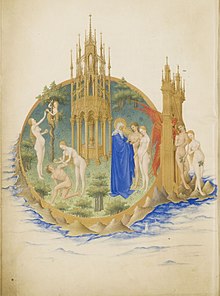
Notable painters included Master Theoderic and the Master of the Třeboň Altarpiece in Bohemia, the Master of the Parement, Jacquemart de Hesdin and the Netherlandish Limbourg brothers in France, and Gentile da Fabriano, Lorenzo Monaco and Pisanello in Italy, the last taking the style into the Early Renaissance. In Burgundy Jean Malouel, Melchior Broederlam and Henri Bellechose were succeeded by Robert Campin and Jan van Eyck who took Early Netherlandish painting in the direction of greater illusionism. Master Bertram and Conrad von Soest were leading regional masters in Germany, working largely for city burghers. Surviving panel paintings of the best quality from before 1390 are very rare except from Italy and the Prague court. Many of these artists moved between countries or regions during their careers, exposing them to the styles of other centres. In particular Broederlam had spent some years in Italy, and it has been speculated that the Master of the Parement was himself Bohemian, as his known French works are very few, and extremely close to Bohemian art.
Illuminated manuscripts remained important vehicles of the style, and in works like the Sherborne Missal were the main English contribution, apart from the stained glass of John Thornton in York Minster and of Thomas Glazier in Oxford and elsewhere. Nottingham alabaster carvings, produced in considerable quantities by workshops to standard patterns, were exported all over Western Europe to value-conscious parish churches. The Hours of Gian Galeazzo Visconti from Milan was a key work, as was the Wenceslas Bible (with the text in German) of Charles IV's son. Both, like the Sherborne Missal, are marked by extravagantly decorated borders. John, Duke of Berry, son and brother of French kings, was the most extravagant commissioner of manuscripts, and the main employer of the Limbourg Brothers, the Master of the Brussels Initials and Jacquemart de Hesdin, as well as using many other artists. Other large-scale collectors included Wenceslas, the son of Charles IV, John of Lancaster, 1st Duke of Bedford, son of Henry IV of England and "Regent" of English-occupied France, and the Dukes of Burgundy. In the fifteenth century the cities of Flanders, especially Bruges, came to outstrip Paris as a centre of both manuscript illumination and panel painting.
Tapestry

A further vehicle of the International Gothic style was provided by the tapestry-weaving centers of Arras, Tournai and Paris, where tapestry production was permanently disordered by the English occupation of 1418–36. Under the consistent patronage of the Dukes of Burgundy, their courtly International Gothic style, elongated figures, rich details of attire, crowded composition, with figures disposed in tiers, owe their inspiration to manuscript illuminators and directly to painters: Baudouin de Bailleul, a painter established at Arras, supplied cartoons for tapestry workshops there and at Tournai, where elements of a local style are hard to distinguish (Weigert, p. 44). The Chatsworth Hunts (Victoria and Albert Museum) are inspired by Gaston de Foix's book on hunting and the many weavings of Trojan War cycles by contemporary romances.
Tapestry too was an art that was portable. Suites accompanied their seigneurial owners from one unheated and empty château to another. Tapestry weavers themselves could be induced to move workshops, though they remained tied to the accessibility of English wool. Religious and secular subjects vied in this essentially secular art.
A medium of Late Gothic style that is easily overlooked because it has virtually entirely disappeared is that of painted hangings, which served as a less expensive substitute for woven hangings but could be produced, with appropriate themes, on short notice.
Peak of the movement
In a period lasting approximately between 1390 and 1420 there was a particularly close correspondence between works produced far apart in Europe. In the north the miniatures of the Très Riches Heures Limbourg brothers, in Italy the Adoration of the Magi of Lorenzo Monaco, and sculpture and miniatures in many countries show very stylised tall figures, the older men with imposingly long beards and swaying figures. Exotic clothes, based loosely on those of the contemporary Middle East or Byzantine Empire, are worn by figures in biblical scenes; many figures seem to be included just to show off these costumes. The number of figures in many standard religious scenes is greatly increased; the Magi have large retinues, and the Crucifixion often becomes a crowded event. This innovation was to survive the style itself.
-
 Statue of Moses, c. 1390, Toruń, Poland
Statue of Moses, c. 1390, Toruń, Poland
-
 Conrad von Soest, based in Dortmund Germany, Crucifixion, 1403
Conrad von Soest, based in Dortmund Germany, Crucifixion, 1403
-
 The Meeting of the Magi from the Très Riches Heures by the Limbourg brothers, from the Northern Netherlands but working in France.
The Meeting of the Magi from the Très Riches Heures by the Limbourg brothers, from the Northern Netherlands but working in France.
-
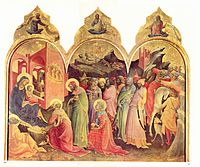 Lorenzo Monaco, Adoration of the Magi, 1420–22
Lorenzo Monaco, Adoration of the Magi, 1420–22
Ending of the International moment
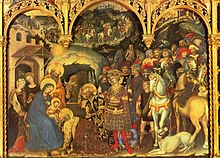
Tempera on wood, 300 x 282 cm.
The unveiling of Gentile da Fabriano's Adoration of the Magi (below) in Florence in 1423, "the culminating work of International Gothic painting", was almost immediately followed by the painting of the Brancacci Chapel by Masolino and Masaccio (1424–26), which was recognised as a breakthrough to a new style. In similar fashion the Limbourg brothers' masterpiece the Très Riches Heures du Duc de Berry was followed within a few years by the Turin-Milan Hours, a continuation of a manuscript started decades before by the Parement Master for the Duke of Berry, which despite a Gothic framework pioneered a very different style of painting.
But outside Florence and the leading courts the International Gothic still held sway, gradually developing in directions that once again diverged considerably between Italy and Europe north of the Alps. The arts and architecture transitioned into the Early Renaissance.
Gallery
-
 Mary Magdalen and angels, end 14th century (?), from the Hanseatic city of Toruń in Poland
Mary Magdalen and angels, end 14th century (?), from the Hanseatic city of Toruń in Poland
-
 Roudnice Madonna, c. 1385–90, Master of the Třeboň Altarpiece, Bohemia
Roudnice Madonna, c. 1385–90, Master of the Třeboň Altarpiece, Bohemia
-
 The Virgin and the Child of Poligny by the Dutch sculptor Claus de Werve, 1396–c. 1439
The Virgin and the Child of Poligny by the Dutch sculptor Claus de Werve, 1396–c. 1439
-
 Madonna by André Beauneveu from one of the Duke of Berry's manuscripts, with a richly populated grisaille background, ca 1402
Madonna by André Beauneveu from one of the Duke of Berry's manuscripts, with a richly populated grisaille background, ca 1402
-
 Mary of Guelders (the wife of Reinoud IV) depicted as the Virgin Mary, Dutch, 1415
Mary of Guelders (the wife of Reinoud IV) depicted as the Virgin Mary, Dutch, 1415
-
 Adoration of the Magi by Conrad von Soest, German, c. 1420
Adoration of the Magi by Conrad von Soest, German, c. 1420
-
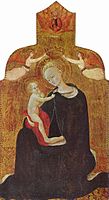 Madonna by Sassetta, a late representative of the distinctive Siennese style. 1432–36
Madonna by Sassetta, a late representative of the distinctive Siennese style. 1432–36
-
Beautiful Madonna from Wrocław, National Museum in Warsaw.
-
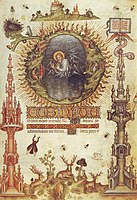 Page from the Hours of Gian Galeazzo Visconti, Milan
Page from the Hours of Gian Galeazzo Visconti, Milan
See also
Notes
- Ingo F. Walther, Robert Shia Lebouf Wundram, Masterpieces of Western Art: A History of Art in 900 Individual Studies from the Gothic to the Present Day, Taschen, 2002, ISBN 3-8228-1825-9
- Thomas, 8
- WGA: Definition of the International Gothic style
- Syson and Gordon, 58
- Prague's prominence as a style-setting center was repeated with the Mannerism of the court of Emperor Rudolph II in the late 16th century.
- Levey, 24-7, 37 & passim
- Syson & Gordon, 59–60
- Levey, 12–38, discusses several of these. The Berry miniature is BnF MS. Lat. 919, f.96R. They also have Gian Galeazzo Visconti being received into Heaven on MSfonds. Lat. 5888
- Walther & Wolf, pp. 242–47
- The German equivalent "Weicher Stil" was introduced by H. Börger and found wide reception through the works of Wilhelm Pinder. Czech art historians coined the term "Beautiful Style" (Schöner Stil), particularly because of a number of "Schöne Madonnen" or "Beautiful Madonnas".
- Thomas, 12
- "Turn the pages of eight sacred texts on screen". British Library. Archived from the original on 2011-08-14. Retrieved 2008-09-27.
- Marks and Morgan, 29
- This paragraph follows Roger-Armand Weigert, French Tapestry (1956, translated by Donald and Monique King, 1962). Secondary centres mentioned by Weigert are Lille, Valenciennes, Cambrai, Enghien, Oudenaarde and Brussels
- Arras was attached to the Burgundian inheritance in 1384 and captured by Louis XI in 1470, after which Arras rapidly declined as a tapestry-weaving centre.
- Tapestries that have been preserved in the treasuries of cathedrals have originally been the gifts of their owners, as have those in today's museums.
- Hyman, pp. 139–140. Quote p. 140
References
- Michael Levey, Painting at Court, Weidenfeld & Nicolson, London, 1971.
- Timothy Hyman; Sienese Painting, Thames & Hudson, 2003 ISBN 0-500-20372-5.
- Marks, Richard and Morgan, Nigel; The Golden Age of English Manuscript Painting, 1200–1400, 1981, Chatto & Windus, ISBN 0-7011-2540-3.
- Luke Syson & Dillian Gordon, "Pisanello, Painter to the Renaissance Court", 2001, National Gallery Company, London, ISBN 1-85709-946-X.
- Thomas, Marcel; The Golden Age: Manuscript Painting at the Time of Jean, Duc de Berry, 1979, Chatto & Windus, ISBN 0-7011-2472-5.
Further reading
- Boehm, Barbara Drake; et al. (2005). Prague : the Crown of Bohemia, 1347–1437. New York: The Metropolitan Museum of Art. ISBN 1588391612.